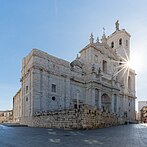Our website is made possible by displaying online advertisements to our visitors.
Please consider supporting us by disabling your ad blocker.
Valladolid
You can help expand this article with text translated from the corresponding article in Spanish. (March 2020) Click [show] for important translation instructions.
|
Valladolid | |
|---|---|
Panoramic view The Town Hall in the Plaza Mayor Landscaped sign installed in the Campo Grande; and the Academia de Caballería | |
| Anthem: Himno a Valladolid | |
 Location of Valladolid | |
| Coordinates: 41°39′10″N 4°43′25″W / 41.65278°N 4.72361°W | |
| Country | Spain |
| Autonomous community | Castile and León |
| Province | Valladolid |
| Founded | 1072 |
| Government | |
| • Type | ayuntamiento |
| • Body | Ayuntamiento de Valladolid |
| • Mayor | Jesús Julio Carnero (2023) |
| Area | |
• Total | 197.47 km2 (76.24 sq mi) |
| Elevation | 698 m (2,290 ft) |
| Population (2024)[1] | |
• Total | 300,618 |
| • Density | 1,500/km2 (3,900/sq mi) |
| Demonym(s) | Vallisoletan Vallisoletano, -a pucelano, -a (informal) |
| Time zone | UTC+1 (CET) |
| • Summer (DST) | UTC+2 (CEST) |
| Postal code | 47001–47016 |
| Dialing code | 983 |
| Website | www |
Valladolid (Spanish: [baʎaðoˈlið] ⓘ) is a municipality in Spain and the primary seat of government and de facto capital of the autonomous community of Castile and León. It is also the capital of the province of Valladolid. It has a population of 300,618 people (2024 est.).[2]
The city is located roughly in the centre of the northern half of the Iberian Peninsula's Meseta Central, at the confluence of the Pisuerga and Esgueva rivers 15 km (9.3 mi) before they join the Duero, surrounded by winegrowing areas. The area was settled in pre-Roman times by the Celtic Vaccaei people, and then by Romans themselves. The settlement was purportedly founded after 1072, growing in prominence within the context of the Crown of Castile, being endowed with fairs and different institutions such as a collegiate church, University (1241), Royal Court and Chancellery and a royal mint.
Valladolid was the location of Europe's first moral debate on the treatment of indigenous people and is the city in which Christopher Columbus died. It was briefly the capital of Habsburg Spain between 1601 and 1606. The city then declined until the arrival of the railway in the 19th century, and with its industrialisation into the 20th century.
The old town is made up of a variety of historic houses, palaces, churches, plazas, avenues and parks, and includes the National Museum of Sculpture as well as the houses of Zorrilla and Cervantes which are open as museums. Notably, the city's Plaza Mayor was the first of its kind in Spain, dating back to the thirteenth century. It was eventually used as a model for similar plazas such as Plaza Mayor in Madrid.
Among the events that are held each year in the city are the famous Holy Week, the World Jigsaw Puzzle Championships, and the Valladolid International Film Festival (Seminci). In 2019, Valladolid was recognised as a City of Film as part of UNESCO's Creative Cities Network. Together with another 15 surrounding municipalities, it belongs to an urban community of around 404,000 inhabitants.[3]
- ^ Municipal Register of Spain 2018. National Statistics Institute.
- ^ "Instituto Nacional de Estadística. (Spanish Statistical Institute)". www.ine.es. Retrieved 26 October 2023.
- ^ "Constituida la Comunidad Urbana de Valladolid, que agrupa a la capital y 15 municipios del entorno". El Norte de Castilla. 23 February 2012.
Previous Page Next Page









